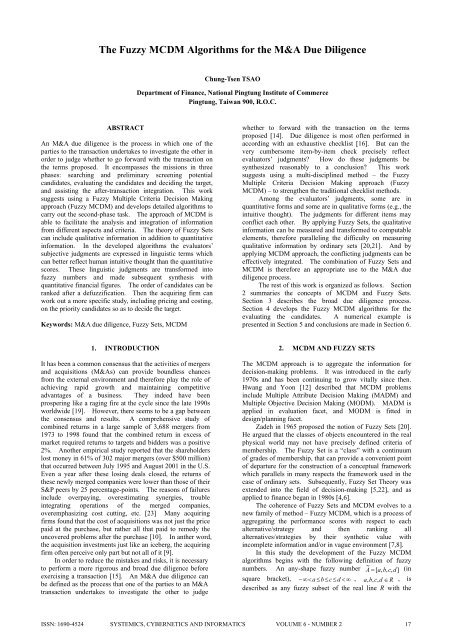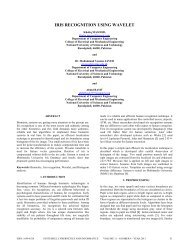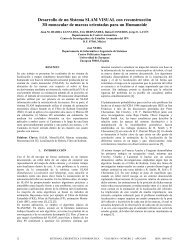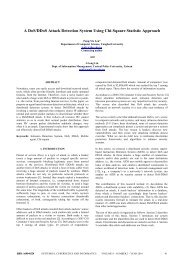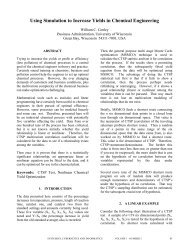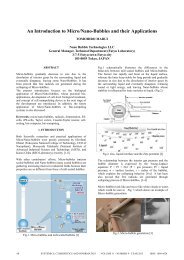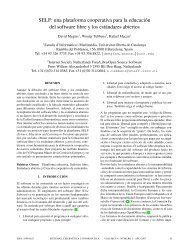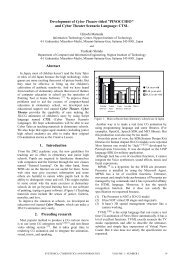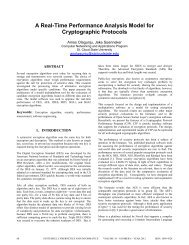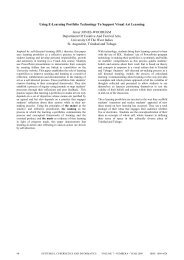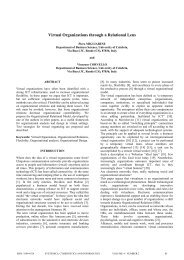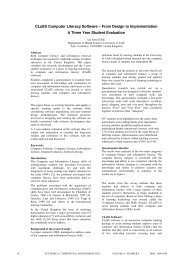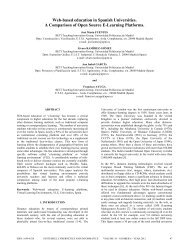The Fuzzy MCDM Algorithms for the M&A Due Diligence
The Fuzzy MCDM Algorithms for the M&A Due Diligence
The Fuzzy MCDM Algorithms for the M&A Due Diligence
Create successful ePaper yourself
Turn your PDF publications into a flip-book with our unique Google optimized e-Paper software.
<strong>The</strong> <strong>Fuzzy</strong> <strong>MCDM</strong> <strong>Algorithms</strong> <strong>for</strong> <strong>the</strong> M&A <strong>Due</strong> <strong>Diligence</strong><br />
Chung-Tsen TSAO<br />
Department of Finance, National Pingtung Institute of Commerce<br />
Pingtung, Taiwan 900, R.O.C.<br />
ABSTRACT<br />
An M&A due diligence is <strong>the</strong> process in which one of <strong>the</strong><br />
parties to <strong>the</strong> transaction undertakes to investigate <strong>the</strong> o<strong>the</strong>r in<br />
order to judge whe<strong>the</strong>r to go <strong>for</strong>ward with <strong>the</strong> transaction on<br />
<strong>the</strong> terms proposed. It encompasses <strong>the</strong> missions in three<br />
phases: searching and preliminary screening potential<br />
candidates, evaluating <strong>the</strong> candidates and deciding <strong>the</strong> target,<br />
and assisting <strong>the</strong> after-transaction integration. This work<br />
suggests using a <strong>Fuzzy</strong> Multiple Criteria Decision Making<br />
approach (<strong>Fuzzy</strong> <strong>MCDM</strong>) and develops detailed algorithms to<br />
carry out <strong>the</strong> second-phase task. <strong>The</strong> approach of <strong>MCDM</strong> is<br />
able to facilitate <strong>the</strong> analysis and integration of in<strong>for</strong>mation<br />
from different aspects and criteria. <strong>The</strong> <strong>the</strong>ory of <strong>Fuzzy</strong> Sets<br />
can include qualitative in<strong>for</strong>mation in addition to quantitative<br />
in<strong>for</strong>mation. In <strong>the</strong> developed algorithms <strong>the</strong> evaluators’<br />
subjective judgments are expressed in linguistic terms which<br />
can better reflect human intuitive thought than <strong>the</strong> quantitative<br />
scores. <strong>The</strong>se linguistic judgments are trans<strong>for</strong>med into<br />
fuzzy numbers and made subsequent syn<strong>the</strong>sis with<br />
quantitative financial figures. <strong>The</strong> order of candidates can be<br />
ranked after a defuzzification. <strong>The</strong>n <strong>the</strong> acquiring firm can<br />
work out a more specific study, including pricing and costing,<br />
on <strong>the</strong> priority candidates so as to decide <strong>the</strong> target.<br />
Keywords: M&A due diligence, <strong>Fuzzy</strong> Sets, <strong>MCDM</strong><br />
whe<strong>the</strong>r to <strong>for</strong>ward with <strong>the</strong> transaction on <strong>the</strong> terms<br />
proposed [14]. <strong>Due</strong> diligence is most often per<strong>for</strong>med in<br />
according with an exhaustive checklist [16]. But can <strong>the</strong><br />
very cumbersome item-by-item check precisely reflect<br />
evaluators’ judgments? How do <strong>the</strong>se judgments be<br />
syn<strong>the</strong>sized reasonably to a conclusion? This work<br />
suggests using a multi-disciplined method – <strong>the</strong> <strong>Fuzzy</strong><br />
Multiple Criteria Decision Making approach (<strong>Fuzzy</strong><br />
<strong>MCDM</strong>) – to streng<strong>the</strong>n <strong>the</strong> traditional checklist methods.<br />
Among <strong>the</strong> evaluators’ judgments, some are in<br />
quantitative <strong>for</strong>ms and some are in qualitative <strong>for</strong>ms (e.g., <strong>the</strong><br />
intuitive thought). <strong>The</strong> judgments <strong>for</strong> different items may<br />
conflict each o<strong>the</strong>r. By applying <strong>Fuzzy</strong> Sets, <strong>the</strong> qualitative<br />
in<strong>for</strong>mation can be measured and trans<strong>for</strong>med to computable<br />
elements, <strong>the</strong>re<strong>for</strong>e paralleling <strong>the</strong> difficulty on measuring<br />
qualitative in<strong>for</strong>mation by ordinary sets [20,21]. And by<br />
applying <strong>MCDM</strong> approach, <strong>the</strong> conflicting judgments can be<br />
effectively integrated. <strong>The</strong> combination of <strong>Fuzzy</strong> Sets and<br />
<strong>MCDM</strong> is <strong>the</strong>re<strong>for</strong>e an appropriate use to <strong>the</strong> M&A due<br />
diligence process.<br />
<strong>The</strong> rest of this work is organized as follows. Section<br />
2 summaries <strong>the</strong> concepts of <strong>MCDM</strong> and <strong>Fuzzy</strong> Sets.<br />
Section 3 describes <strong>the</strong> broad due diligence process.<br />
Section 4 develops <strong>the</strong> <strong>Fuzzy</strong> <strong>MCDM</strong> algorithms <strong>for</strong> <strong>the</strong><br />
evaluating <strong>the</strong> candidates. A numerical example is<br />
presented in Section 5 and conclusions are made in Section 6.<br />
1. INTRODUCTION<br />
It has been a common consensus that <strong>the</strong> activities of mergers<br />
and acquisitions (M&As) can provide boundless chances<br />
from <strong>the</strong> external environment and <strong>the</strong>re<strong>for</strong>e play <strong>the</strong> role of<br />
achieving rapid growth and maintaining competitive<br />
advantages of a business. <strong>The</strong>y indeed have been<br />
prospering like a raging fire at <strong>the</strong> cycle since <strong>the</strong> late 1990s<br />
worldwide [19]. However, <strong>the</strong>re seems to be a gap between<br />
<strong>the</strong> consensus and results. A comprehensive study of<br />
combined returns in a large sample of 3,688 mergers from<br />
1973 to 1998 found that <strong>the</strong> combined return in excess of<br />
market required returns to targets and bidders was a positive<br />
2%. Ano<strong>the</strong>r empirical study reported that <strong>the</strong> shareholders<br />
lost money in 61% of 302 major mergers (over $500 million)<br />
that occurred between July 1995 and August 2001 in <strong>the</strong> U.S.<br />
Even a year after <strong>the</strong>se losing deals closed, <strong>the</strong> returns of<br />
<strong>the</strong>se newly merged companies were lower than those of <strong>the</strong>ir<br />
S&P peers by 25 percentage-points. <strong>The</strong> reasons of failures<br />
include overpaying, overestimating synergies, trouble<br />
integrating operations of <strong>the</strong> merged companies,<br />
overemphasizing cost cutting, etc. [23] Many acquiring<br />
firms found that <strong>the</strong> cost of acquisitions was not just <strong>the</strong> price<br />
paid at <strong>the</strong> purchase, but ra<strong>the</strong>r all that paid to remedy <strong>the</strong><br />
uncovered problems after <strong>the</strong> purchase [10]. In an<strong>the</strong>r word,<br />
<strong>the</strong> acquisition investments just like an iceberg, <strong>the</strong> acquiring<br />
firm often perceive only part but not all of it [9].<br />
In order to reduce <strong>the</strong> mistakes and risks, it is necessary<br />
to per<strong>for</strong>m a more rigorous and broad due diligence be<strong>for</strong>e<br />
exercising a transaction [15]. An M&A due diligence can<br />
be defined as <strong>the</strong> process that one of <strong>the</strong> parties to an M&A<br />
transaction undertakes to investigate <strong>the</strong> o<strong>the</strong>r to judge<br />
2. <strong>MCDM</strong> AND FUZZY SETS<br />
<strong>The</strong> <strong>MCDM</strong> approach is to aggregate <strong>the</strong> in<strong>for</strong>mation <strong>for</strong><br />
decision-making problems. It was introduced in <strong>the</strong> early<br />
1970s and has been continuing to grow vitally since <strong>the</strong>n.<br />
Hwang and Yoon [12] described that <strong>MCDM</strong> problems<br />
include Multiple Attribute Decision Making (MADM) and<br />
Multiple Objective Decision Making (MODM). MADM is<br />
applied in evaluation facet, and MODM is fitted in<br />
design/planning facet.<br />
Zadeh in 1965 proposed <strong>the</strong> notion of <strong>Fuzzy</strong> Sets [20].<br />
He argued that <strong>the</strong> classes of objects encountered in <strong>the</strong> real<br />
physical world may not have precisely defined criteria of<br />
membership. <strong>The</strong> <strong>Fuzzy</strong> Set is a “class” with a continuum<br />
of grades of membership, that can provide a convenient point<br />
of departure <strong>for</strong> <strong>the</strong> construction of a conceptual framework<br />
which parallels in many respects <strong>the</strong> framework used in <strong>the</strong><br />
case of ordinary sets. Subsequently, <strong>Fuzzy</strong> Set <strong>The</strong>ory was<br />
extended into <strong>the</strong> field of decision-making [5,22], and as<br />
applied to finance began in 1980s [4,6].<br />
<strong>The</strong> coherence of <strong>Fuzzy</strong> Sets and <strong>MCDM</strong> evolves to a<br />
new family of method – <strong>Fuzzy</strong> <strong>MCDM</strong>, which is a process of<br />
aggregating <strong>the</strong> per<strong>for</strong>mance scores with respect to each<br />
alternative/strategy and <strong>the</strong>n ranking all<br />
alternatives/strategies by <strong>the</strong>ir syn<strong>the</strong>tic value with<br />
incomplete in<strong>for</strong>mation and/or in vague environment [7,8].<br />
In this study <strong>the</strong> development of <strong>the</strong> <strong>Fuzzy</strong> <strong>MCDM</strong><br />
algorithms begins with <strong>the</strong> following definition of fuzzy<br />
numbers. An any-shape fuzzy number<br />
~<br />
A = [ a,<br />
b,<br />
c,<br />
d]<br />
(in<br />
square bracket), −∞<<br />
a ≤b≤c<br />
≤ d < ∞ , a, b,<br />
c,<br />
d ∈ R , is<br />
described as any fuzzy subset of <strong>the</strong> real line R with <strong>the</strong><br />
ISSN: 1690-4524<br />
SYSTEMICS, CYBERNETICS AND INFORMATICS VOLUME 6 - NUMBER 2 17
membership function<br />
~ ( x)<br />
. <strong>The</strong> membership function<br />
f A<br />
f ~ A<br />
( x)<br />
is a continuous mapping from R to <strong>the</strong> closed interval<br />
[0,1]; f ~ A<br />
( x)<br />
is strictly increasing on x ∈ [ a,<br />
b]<br />
; f ~ A<br />
( x)<br />
= 1<br />
<strong>for</strong> x ∈ [ b,<br />
c]<br />
; f ~ A<br />
( x)<br />
is strictly decreasing on x ∈ [ c,<br />
d ] ;<br />
f ~ A<br />
( x)<br />
= 0 <strong>for</strong> all x ∈ ( −∞,<br />
a]<br />
and x ∈[ d,<br />
∞)<br />
[7]. A fuzzy<br />
number ~<br />
B = ( e,<br />
f , g,<br />
h)<br />
(in round bracket) is defined as a<br />
trapezoidal one if f ~ B<br />
( x)<br />
is given by [13]:<br />
⎧ f<br />
⎪<br />
f ~ ( x)<br />
=<br />
B ⎨<br />
⎪ f<br />
⎪<br />
⎩<br />
L<br />
~<br />
B<br />
R<br />
~<br />
B<br />
( x)<br />
= ( x − e) /( f − e),<br />
1<br />
( x)<br />
= ( x − h) /( g − h),<br />
0,<br />
e ≤ x ≤ f ,<br />
f ≤ x ≤ g<br />
g ≤ x ≤ h,<br />
o<strong>the</strong>rwise,<br />
where f ~ L ( x)<br />
and f ~ R ( x)<br />
respectively denote <strong>the</strong> left and<br />
B<br />
B<br />
right membership functions.<br />
<strong>The</strong> α-cut of a fuzzy number A ~ is denoted by<br />
α ~ α α<br />
α α<br />
A = [ A,<br />
A]<br />
, where A and A are respectively <strong>the</strong><br />
lower and upper bounds of <strong>the</strong> closed interval <strong>for</strong> <strong>the</strong> level of<br />
α, α ∈[0,1]<br />
. <strong>The</strong> α-cut of a trapezoidal fuzzy number<br />
~<br />
B = ( e,<br />
f , g,<br />
h)<br />
is expressed as [13]:<br />
α<br />
~ α α<br />
B = [ B,<br />
B]<br />
=<br />
α +<br />
(1)<br />
[(<br />
f − e)<br />
α + e,(<br />
g − h)<br />
h]<br />
, (2)<br />
Equations (3)~(5) are <strong>the</strong> standard fuzzy-arithmetic<br />
operational rules applied in this work [13]:<br />
α<br />
α<br />
α<br />
α α α α<br />
[ A+<br />
B,<br />
A+<br />
B]<br />
α α α α<br />
[ A−<br />
B,<br />
A−<br />
B]<br />
~ ~ α ~ α ~<br />
( A + B)<br />
= A+<br />
B =<br />
, (3)<br />
~ ~ α~<br />
α ~<br />
( A − B)<br />
= A−<br />
B =<br />
, (4)<br />
~ ~<br />
α α α α α α α α<br />
( A×<br />
B)<br />
= [ min( A⋅<br />
B,<br />
A⋅<br />
B,<br />
A⋅<br />
B,<br />
A⋅<br />
B),<br />
α α α α α α α α<br />
max( A⋅ B,<br />
A⋅<br />
B,<br />
A⋅<br />
B,<br />
A⋅<br />
B . (5)<br />
)]<br />
Drawing up <strong>the</strong> qualifications: It would be <strong>the</strong> best<br />
to list <strong>the</strong> qualifications <strong>for</strong> <strong>the</strong> target item-by-item in <strong>the</strong><br />
plan. <strong>The</strong>y are used as <strong>the</strong> key to search <strong>for</strong> potential<br />
candidates. <strong>The</strong> items generally include: <strong>the</strong> category of <strong>the</strong><br />
industry, specific techniques, products/services, geographic<br />
location, market, minimal and/or maximal size, etc.<br />
Searching <strong>for</strong> <strong>the</strong> potential candidates: <strong>The</strong><br />
candidates satisfy <strong>the</strong> qualifications may exist somewhere<br />
beyond <strong>the</strong> acquirer’s intuitive vision. It <strong>the</strong>re<strong>for</strong>e is better<br />
to systematically access <strong>the</strong> potential candidates in stead of<br />
relying on insiders’ clues [11]. It’ll be efficient to take up<br />
<strong>the</strong> potential candidates from some business databases, using<br />
<strong>the</strong> key of items found in <strong>the</strong> previous subsection.<br />
Preliminary screening: In order to delete <strong>the</strong> unfitted<br />
candidates, <strong>the</strong> potential ones are be filtered by some<br />
negative factors, such as: <strong>the</strong> critical weakness, critical<br />
litigation, huge liabilities, labor problems, legal obstacles<br />
(Antitrust or government regulations), and/or political<br />
instability on doing <strong>the</strong> transaction [17]? After <strong>the</strong><br />
screening, <strong>the</strong> retained candidates are fur<strong>the</strong>r evaluated in<br />
next phase.<br />
Phase II – Evaluating and ranking <strong>the</strong> candidates (See<br />
Section 4)<br />
3.2. Phase III – Assisting <strong>the</strong> after-transaction integration<br />
This phase is to integrate <strong>the</strong> two operating entities after<br />
finalizing <strong>the</strong> purchase. <strong>The</strong> key concern is <strong>the</strong> multi-business<br />
coordination to increase <strong>the</strong> sales, improve <strong>the</strong> operations,<br />
take <strong>the</strong> expected new markets, and increase <strong>the</strong><br />
stockholders’ wealth. Since <strong>the</strong> committee members who<br />
executed <strong>the</strong> previous two phases have <strong>the</strong> most detailed<br />
in<strong>for</strong>mation of <strong>the</strong> whole transaction, <strong>the</strong>y should continue to<br />
offer <strong>the</strong> necessary assistance to <strong>the</strong> integration [11].<br />
3. THE DUE DILIGENCE PROCESS<br />
A broad M&A due diligence process encompasses three<br />
phases: searching and preliminary screening <strong>the</strong> potential<br />
candidates, evaluating <strong>the</strong> candidates and deciding <strong>the</strong><br />
ranking order, and assisting in <strong>the</strong> after-transaction<br />
integration [10]. <strong>The</strong> following subsections outline <strong>the</strong><br />
main points at each phase. <strong>The</strong> <strong>Fuzzy</strong> <strong>MCDM</strong> algorithms<br />
as applied at <strong>the</strong> second phase are developed independently<br />
in Section 4.<br />
3.1. Phase I – Searching <strong>for</strong> <strong>the</strong> potential candidates<br />
Identifying <strong>the</strong> motivation and purposes and setting up<br />
<strong>the</strong> transaction strategy<br />
It is <strong>the</strong> first thing that an enterprise has to do be<strong>for</strong>e<br />
contributing to <strong>the</strong> M&A activities to identify its expectation<br />
from <strong>the</strong> transaction. That is, to figure out explicitly <strong>the</strong><br />
motivation and purpose of doing <strong>the</strong> transaction. In ano<strong>the</strong>r<br />
word, it is to confirm <strong>the</strong> transaction strategic <strong>the</strong>orem which<br />
is consistent with <strong>the</strong> firm strategic goals. <strong>The</strong> transaction<br />
strategy can be clarified by <strong>the</strong> strategic value generated from<br />
<strong>the</strong> transaction, such as protective value (by defending<br />
existing business), enhancing value (by building <strong>the</strong> existing<br />
competitive position), synergistic value (by capturing joint<br />
value-chain benefits), future opportunity value (through<br />
generating a plat<strong>for</strong>m, or stream of future opportunities), and<br />
sweat value (tightening operational and financial controls)<br />
[9,12]. And <strong>the</strong> acquirer projects itself as <strong>the</strong> role in <strong>the</strong><br />
industry through and after <strong>the</strong> transaction.<br />
4. THE FUZZY <strong>MCDM</strong> ALGORITHMS<br />
In this section a set of <strong>Fuzzy</strong> <strong>MCDM</strong> algorithms are<br />
suggested to evaluate <strong>the</strong> candidates.<br />
4.1. Setting up <strong>the</strong> analytical hierarchy<br />
<strong>The</strong> analytical hierarchy can be one-level, two-level, or<br />
multi-level, by <strong>the</strong> preference or demands of <strong>the</strong> committee.<br />
This work adopts <strong>the</strong> two-level structure. <strong>The</strong> first level is<br />
composed of several aspects, such as marketing, production,<br />
finance, in<strong>for</strong>mation, R&D, human resources, legality,<br />
environment, intangible assets, etc. [10] <strong>The</strong> second level<br />
consists of <strong>the</strong> subordinate evaluation criteria. <strong>The</strong><br />
committee members have to review and make <strong>the</strong>ir<br />
judgments on <strong>the</strong> importance of each aspect and criterion,<br />
and on <strong>the</strong> ratings <strong>for</strong> each candidate versus each criterion.<br />
<strong>The</strong> judgments are in ei<strong>the</strong>r linguistic terms or quantitative<br />
values (to be detailed later). Here, all criteria are<br />
categorized into <strong>the</strong> benefit-nature, cost-nature, and<br />
medium-nature ones. For benefit-nature criteria, a greater<br />
value is better (e.g. earnings per share). For cost-nature<br />
criteria, a smaller value is better (e.g. bankruptcy probability<br />
and <strong>the</strong> debt ratio). For <strong>the</strong> medium nature, <strong>the</strong> median is<br />
<strong>the</strong> best case whereas a value far<strong>the</strong>r away from <strong>the</strong> median<br />
is a worse case (e.g. <strong>the</strong> ratio of current asset to current<br />
liability).<br />
4.2. Determining <strong>the</strong> linguistic sets and <strong>the</strong> corresponding<br />
fuzzy numbers <strong>for</strong> importance weights and ratings<br />
18 SYSTEMICS, CYBERNETICS AND INFORMATICS VOLUME 6 - NUMBER 2 ISSN: 1690-4524
Let '<br />
x ijkl<br />
denote <strong>the</strong> original rating assessed <strong>for</strong> candidate i<br />
versus criterion k under aspect j by evaluator l; '<br />
x ijkl<br />
is ei<strong>the</strong>r<br />
a linguistic term or a quantitative value. Let W jl and w jkl<br />
respectively represent <strong>the</strong> importance weights assigned by<br />
evaluator l to aspect j and to criterion k under aspect j; W jl<br />
and w jkl are assessed in linguistic terms [17]. Suppose that<br />
<strong>the</strong> committee agrees with using <strong>the</strong> linguistic weighting set<br />
Ω = { ϖ 1 ,..., ϖ b } and <strong>the</strong> linguistic rating set R = { γ 1 ,..., γ a } to<br />
measure <strong>the</strong> qualitative ratings and <strong>the</strong> importance weights,<br />
where γ 1,...,γ a<br />
and ϖ 1,...,ϖ b<br />
are <strong>the</strong> linguistic terms;<br />
a, b ∈ N . Let trapezoidal fuzzy number<br />
w ~<br />
jkl<br />
= ( a<br />
jkl,<br />
bjkl,<br />
c<br />
jkl,<br />
d<br />
jkl)<br />
denote <strong>the</strong> importance weight given to<br />
criterion k under aspect j by evaluator l, where<br />
0≤ajkl<br />
≤bjkl<br />
≤cjkl<br />
≤djkl<br />
≤1<br />
; let trapezoidal fuzzy number<br />
~<br />
W jl = ( wjl,<br />
x jl,<br />
y jl,<br />
z jl)<br />
be <strong>the</strong> weight assigned to aspect j by<br />
evaluator l, where<br />
0≤wjl<br />
≤xjl<br />
≤ yjl<br />
≤zjl<br />
≤1<br />
; let trapezoidal fuzzy<br />
number ~ x ijkl = ( oijkl<br />
, pijkl<br />
, qijkl<br />
, rijkl<br />
) denote <strong>the</strong> fuzzy ratings<br />
representing <strong>the</strong> linguistic terms given to candidate i versus<br />
criterion k under aspect j by evaluator l, where<br />
0 ≤ oijkl<br />
≤ pijkl<br />
≤ qijkl<br />
≤ rijkl<br />
≤1<br />
.<br />
<strong>The</strong> committee can discretionarily set up <strong>the</strong> linguistic<br />
terms and corresponding fuzzy numbers to fit <strong>for</strong> <strong>the</strong> needs.<br />
This study assumes Ω = ϖ , ϖ , ϖ , } and R = γ , γ , γ , },<br />
where<br />
1<br />
{ 1 2 3 ϖ 4<br />
ϖ =Unimportant=(0,0,0.1,0.3),<br />
ϖ =Important=(0.4,0.6,0.7,0.9),<br />
3<br />
=(0.7,0.9,1,1),<br />
λ 3<br />
ϖ 4<br />
λ =poor=(0,0,0.1,0.3),<br />
1<br />
=Good=(0.4,0.6,0.7,0.9),<br />
λ 4<br />
ϖ 2<br />
{ 1 2 3 γ 4<br />
=fair=(0.1,0.3,0.4,0.6),<br />
=Extremely Important<br />
λ =fair=(0.1,0.3,0.4,0.6),<br />
2<br />
=Excellent=(0.7,0.9,1,1).<br />
<strong>The</strong> scales of R and Ω are assigned to be <strong>the</strong> same here<br />
<strong>for</strong> simplicity and consistency.<br />
4.3. Trans<strong>for</strong>ming <strong>the</strong> quantitative ratings<br />
<strong>The</strong> quantitative figures may be in different nature and/or<br />
units, e.g. as monetary value or percentage. <strong>The</strong>se figures<br />
need to be trans<strong>for</strong>med to assure compatibility with each<br />
o<strong>the</strong>r. This work proposes <strong>the</strong> percentile method, which is<br />
to cut <strong>the</strong> observations by <strong>the</strong> tenth, fiftieth, and ninetieth<br />
percentiles and group <strong>the</strong> ratings versus each criterion into<br />
four sets of fuzzy numbers:<br />
~ x<br />
~ x<br />
~ x<br />
ijkl<br />
ijkl<br />
ijkl<br />
⎧γ<br />
1,<br />
x<br />
⎪<br />
γ 2,<br />
δ<br />
= ⎨<br />
⎪<br />
γ 3,<br />
δ<br />
⎪<br />
⎩γ<br />
4,<br />
x<br />
⎧γ<br />
4,<br />
x<br />
⎪<br />
γ 3,<br />
δ<br />
= ⎨<br />
⎪<br />
γ 2,<br />
δ<br />
⎪<br />
⎩γ<br />
1,<br />
x<br />
ijkl<br />
jk10<br />
jk50<br />
ijkl<br />
ijkl<br />
jk10<br />
jk50<br />
ijkl<br />
≤ δ<br />
< x<br />
< x<br />
> δ<br />
≤ δ<br />
< x<br />
< x<br />
> δ<br />
,<br />
jk10<br />
ijkl<br />
ijkl<br />
jk90<br />
≤ δ<br />
≤ δ<br />
,<br />
,<br />
jk10<br />
ijkl<br />
ijkl<br />
jk90<br />
≤ δ<br />
≤ δ<br />
,<br />
,<br />
jk50<br />
,<br />
jk90<br />
,<br />
jk50<br />
,<br />
jk90<br />
⎧γ<br />
1,<br />
xijkl<br />
≤ δ<br />
jk5,<br />
xijkl<br />
> δ<br />
jk95,<br />
⎪<br />
γ<br />
2,<br />
δ<br />
jk5<br />
< xijkl<br />
≤ δ<br />
jk10,<br />
δ<br />
= ⎨<br />
⎪<br />
γ<br />
3,<br />
δ<br />
jk10<br />
< xijkl<br />
≤ δ<br />
jk25,<br />
δ<br />
⎪<br />
⎩γ<br />
4,<br />
δ<br />
jk25<br />
< xijkl<br />
≤ δ<br />
jk50,<br />
δ<br />
jk90<br />
jk75<br />
jk50<br />
x ijkl ∈ B,<br />
(6)<br />
x ijkl ∈ C,<br />
(7)<br />
< x<br />
ijkl<br />
< x<br />
< x<br />
ijkl<br />
ijkl<br />
≤ δ<br />
≤ δ<br />
≤ δ<br />
jk95<br />
,<br />
,<br />
,<br />
jk90<br />
jk75<br />
x ijkl<br />
∈ M, (8)<br />
where x and x~<br />
ijkl<br />
ijkl<br />
respectively denote <strong>the</strong> original<br />
quantitative rating in crisp numbers and <strong>the</strong> trans<strong>for</strong>med<br />
rating in fuzzy numbers. Terms δ , δ ,<br />
jk5 jk10 δ<br />
jk 25,<br />
δ<br />
jk50,<br />
δ<br />
jk 75,<br />
δ and<br />
jk90<br />
δ<br />
jk95<br />
are <strong>the</strong> fifth, tenth, twenty-fifth,<br />
fiftieth, seventy-fifth, ninetieth, and ninety-fifth percentiles,<br />
respectively. Symbols B, C, and M respectively denote <strong>the</strong><br />
benefit, cost, and medium natures. <strong>The</strong> scales γ 1<br />
,…, γ<br />
are set <strong>the</strong> same as <strong>the</strong> qualitative ratings <strong>for</strong> consistency.<br />
<strong>The</strong> trans<strong>for</strong>mation method is based on <strong>the</strong> assumption of<br />
approximate normal distribution. In a normal distribution<br />
99.7% observations are in <strong>the</strong> range of μ ± 3σ<br />
. Cutting<br />
<strong>the</strong> range into four equal distances, ( μ − 3σ<br />
, μ − 1.5σ<br />
] ,<br />
( μ − 1.5σ<br />
, μ ] , ( μ , μ + 1.5σ<br />
] , and ( μ + 1.5σ<br />
, μ + 3σ<br />
)<br />
respectively account <strong>for</strong> 6.7%, 43.3%, 43.3%, and 6.7%<br />
probabilities. <strong>The</strong>se four numbers are rounded into 10%,<br />
40%, 40%, and 10%. <strong>The</strong>y are <strong>the</strong> corresponding<br />
probabilities cut by <strong>the</strong> first, fifth, and ninth percentiles.<br />
4.4. <strong>The</strong> syn<strong>the</strong>sis using standard fuzzy arithmetic<br />
<strong>The</strong> syn<strong>the</strong>sis of evaluation is per<strong>for</strong>med by <strong>the</strong> standard<br />
fuzzy arithmetic [13]. Applying Eq. (2):<br />
α<br />
α<br />
ijkl<br />
[(<br />
p − o ) α + o ,( q − r ) r ]<br />
~ x = α + , (9)<br />
jkl<br />
ijkl<br />
ijkl<br />
ijkl<br />
[(<br />
b − a ) α + a ,( c − d ) d ]<br />
jkl<br />
jkl<br />
jkl<br />
ijkl<br />
w ~ = α + , (10)<br />
jl<br />
jkl<br />
ijkl<br />
[(<br />
x − w ) α + w ,( y − z ) z ]<br />
W ~ = α + . (11)<br />
α<br />
jl<br />
jl<br />
<strong>The</strong> syn<strong>the</strong>sis is per<strong>for</strong>med as follows:<br />
jl<br />
jl<br />
jl<br />
δ<br />
δ m<br />
α ~ ⎛ α ~ ⎞ ⎛<br />
α ~ α ~ ⎞<br />
Si = ⎜∑<br />
S il ⎟ / δ = ⎜ ( ) ⎟ / δ<br />
⎝ l = 1 ⎠<br />
∑∑ W jl<br />
× Sijl<br />
⎝ l = 1 j=<br />
1<br />
⎠<br />
⎛<br />
δ m<br />
n j<br />
α ~<br />
α ~ α<br />
( ( ~ ⎞<br />
= ⎜<br />
)) ⎟<br />
∑∑<br />
W<br />
jl<br />
× ∑ w<br />
jkl<br />
× xijkl<br />
/ δ<br />
⎝ l = 1 j=<br />
1<br />
k = 1<br />
⎠<br />
⎡⎛⎛<br />
δ m<br />
⎞<br />
⎢⎜<br />
⎛<br />
n j<br />
⎞⎞<br />
⎜<br />
⎟ ⎟ 3<br />
=<br />
⎜<br />
( ) [( )( )]<br />
⎟<br />
/ δ α<br />
⎢⎜<br />
⎟<br />
⎜∑∑ x<br />
⎜<br />
jl − w jl ⋅∑<br />
bjkl<br />
− a jkl pijkl<br />
− oijkl<br />
⎟<br />
⎢<br />
1 1 1<br />
⎟<br />
⎣⎝⎝<br />
l= j= ⎝<br />
k=<br />
⎠⎠<br />
⎠<br />
⎛⎛<br />
δ m<br />
⎜<br />
⎛<br />
n j<br />
⎜<br />
+<br />
⎜<br />
⎜<br />
⎜ ∑∑ w ⋅ − −<br />
⎜<br />
jl ∑ [( b jkl a jkl )( pijkl<br />
oijkl<br />
)]<br />
⎝⎝<br />
l= 1 j= 1⎝<br />
k = 1<br />
n j<br />
⎞⎞<br />
2<br />
( ) [ ( ) ( )] / δ ⎟ ⎟ ⎞<br />
⎟<br />
+ x<br />
⎟<br />
jl − wjl<br />
⋅∑<br />
a jkl pijkl<br />
− oijkl<br />
+ oijkl<br />
bjkl<br />
− a jkl α<br />
⎟<br />
1<br />
⎟<br />
k=<br />
⎠<br />
⎠ ⎠<br />
⎛⎛<br />
δ m<br />
n j<br />
⎜<br />
⎛<br />
+ ⎜ ⎜<br />
⎜<br />
∑∑ w<br />
jl<br />
⋅∑[<br />
a<br />
jkl<br />
( pijkl<br />
− oijkl<br />
) + oijkl<br />
( b<br />
jkl<br />
− a<br />
jkl<br />
)]<br />
⎝⎝<br />
l= 1 j= 1⎝<br />
k = 1<br />
n j ⎞⎞<br />
δ ⎟ ⎟ ⎞<br />
⎟<br />
+ ( x<br />
⎟<br />
jl − w jl ) ⋅∑a<br />
jkloijkl<br />
⎟<br />
⎟<br />
/<br />
k = 1 ⎠<br />
⎠ ⎠α<br />
⎛<br />
δ m n j<br />
⎞<br />
⎜ (<br />
) ⎟<br />
,<br />
+ ∑∑ w<br />
jl<br />
⋅∑a<br />
jkloijkl<br />
/ δ<br />
⎝ l= 1 j= 1 k = 1 ⎠<br />
⎛⎛<br />
δ m<br />
⎞<br />
⎜<br />
⎛<br />
nj<br />
⎞⎞<br />
⎜ ⎜<br />
⎟ 3<br />
⎜ ( ) ( )( )<br />
⎟⎟<br />
/ δ ⎟α<br />
⎜∑∑<br />
y<br />
⎜<br />
jl −z<br />
jl ⋅∑<br />
cjkl<br />
−d<br />
jkl qijkl<br />
−rijkl<br />
⎟<br />
1 1 1<br />
⎟<br />
⎝⎝<br />
l= j= ⎝<br />
k=<br />
⎠⎠<br />
⎠<br />
⎛⎛<br />
δ m<br />
⎜<br />
⎛<br />
n j<br />
⎜<br />
+<br />
⎜<br />
⎜<br />
⎜∑∑ z ⋅ − −<br />
⎜ jl ∑(<br />
c jkl d jkl )( qijkl<br />
rijkl<br />
)<br />
⎝⎝<br />
l= 1 l= 1⎝<br />
k = 1<br />
n j<br />
⎞⎞<br />
2<br />
( ) [ ( ) ( )] / δ ⎟ ⎟ ⎞<br />
⎟<br />
+ y<br />
⎟<br />
jl − z jl ⋅∑<br />
d jkl qijkl<br />
− rijkl<br />
+ rijkl<br />
c jkl − d jkl α<br />
⎟<br />
1<br />
⎟<br />
k=<br />
⎠<br />
⎠ ⎠<br />
⎛⎛<br />
δ m<br />
⎜<br />
⎛<br />
n j<br />
⎜<br />
+<br />
⎜<br />
⎜<br />
⎜∑∑ z ⋅<br />
− + −<br />
⎜ jl ∑[<br />
d jkl ( qijkl<br />
rijkl<br />
) rijkl<br />
( c jkl d jkl )]<br />
⎝⎝<br />
l= 1 j= 1⎝<br />
k = 1<br />
n j<br />
⎞⎞<br />
δ ⎟ ⎞<br />
+ ( y<br />
⎟⎟<br />
jl<br />
− z<br />
jl<br />
) ⋅∑d<br />
jklrijkl<br />
/ α<br />
k = 1 ⎠ ⎟<br />
⎠ ⎠<br />
jkl<br />
jl<br />
ijkl<br />
jkl<br />
4<br />
ISSN: 1690-4524<br />
SYSTEMICS, CYBERNETICS AND INFORMATICS VOLUME 6 - NUMBER 2 19
⎛ δ<br />
⎜<br />
⎜<br />
⎝<br />
l<br />
m<br />
⎛<br />
⎜<br />
z ⋅<br />
⎜ jl<br />
⎝<br />
j<br />
+ ∑∑ ∑<br />
n<br />
= 1 j = 1 k = 1<br />
d<br />
r<br />
jkl ijkl<br />
⎞⎞<br />
⎤<br />
⎟⎟<br />
⎥<br />
⎟<br />
/ δ<br />
⎟ ⎥<br />
⎠⎠<br />
⎥⎦<br />
, (12)<br />
where S ~ denotes <strong>the</strong> final fuzzy syn<strong>the</strong>sis value <strong>for</strong><br />
i<br />
candidate i, S ~ denotes <strong>the</strong> fuzzy syn<strong>the</strong>sis value <strong>for</strong><br />
il<br />
candidate i by evaluator l, S ~ denotes <strong>the</strong> fuzzy syn<strong>the</strong>sis<br />
ijl<br />
value <strong>for</strong> candidate i versus aspect j by evaluator l, and δ is<br />
<strong>the</strong> number of evaluators. Let<br />
⎛ δ m<br />
nj<br />
⎛<br />
⎞⎞<br />
,<br />
E ⎜ ⎜(<br />
) [( )( )] ⎟⎟<br />
Li<br />
= / δ<br />
∑∑ xjl<br />
−wjl<br />
⋅∑<br />
bjkl<br />
−ajkl<br />
pijkl<br />
−oijkl<br />
⎝ l= 1 j= 1⎝<br />
k=<br />
1<br />
⎠⎠<br />
⎛ δ m n j<br />
⎛<br />
F ⎜ ⎜<br />
Li<br />
= ∑∑ wjl<br />
⋅∑[(<br />
bjkl<br />
− a<br />
jkl)(<br />
pijkl<br />
−oijkl)]<br />
⎝<br />
l= 1 j= 1⎝<br />
k=<br />
1<br />
n j<br />
⎞<br />
( ) [ ( ) ( )] /δ<br />
⎟ ⎞ ,<br />
+ x − ⋅∑<br />
− + − ⎟<br />
jl<br />
wjl<br />
a<br />
jkl<br />
pijkl<br />
oijkl<br />
oijkl<br />
bjkl<br />
a<br />
jkl<br />
k=<br />
1 ⎠⎠<br />
⎛ δ m n j<br />
⎛<br />
H ⎜ ⎜<br />
Li<br />
= ∑∑ wjl<br />
⋅∑[<br />
a<br />
jkl(<br />
pijkl<br />
−oijkl)<br />
+ oijkl(<br />
bjkl<br />
− a<br />
jkl)]<br />
⎝<br />
l= 1 j= 1⎝<br />
k=<br />
1<br />
n j<br />
⎞<br />
( ) /δ<br />
⎟ ⎞ ,<br />
+ x − ⋅∑<br />
⎟<br />
jl<br />
wjl<br />
a<br />
jkloijkl<br />
k=<br />
1 ⎠⎠<br />
⎛<br />
δ m n j<br />
⎞ ,<br />
Q ⎜ (<br />
) ⎟<br />
i<br />
= ∑∑ wjl<br />
⋅∑a<br />
jkloijkl<br />
/ δ<br />
⎝ l= 1 j= 1 k=<br />
1 ⎠<br />
⎛ δ m<br />
n j<br />
⎛<br />
⎞<br />
( ) ( )( ) / δ<br />
⎟ ⎞ ,<br />
E ⎜ ⎜<br />
⎟<br />
Ri<br />
= ∑∑ y<br />
jl<br />
− z<br />
jl<br />
⋅∑<br />
cjkl<br />
− d<br />
jkl<br />
qijkl<br />
− rijkl<br />
⎝<br />
l= 1 j= 1⎝<br />
k = 1 ⎠⎠<br />
⎛ δ m n j<br />
⎛<br />
F ⎜ ⎜<br />
Ri<br />
= ∑∑ z<br />
jl<br />
⋅∑(<br />
c<br />
jkl<br />
− d<br />
jkl)(<br />
qijkl<br />
− rijkl)<br />
⎝<br />
l= 1 l= 1⎝<br />
k=<br />
1<br />
n j<br />
⎞<br />
( ) [ ( ) ( )] /δ<br />
⎟ ⎞ ,<br />
+ y − ⋅∑<br />
− + − ⎟<br />
jl<br />
z<br />
jl<br />
d<br />
jkl<br />
qijkl<br />
rijkl<br />
rijkl<br />
cjkl<br />
d<br />
jkl<br />
k=<br />
1 ⎠⎠<br />
⎛ δ m n j<br />
⎛<br />
H ⎜ ⎜<br />
Ri<br />
= ∑∑ z<br />
jl<br />
⋅∑[<br />
d<br />
jkl(<br />
qijkl<br />
− rijkl)<br />
+ rijkl(<br />
c<br />
jkl<br />
− d<br />
jkl)]<br />
⎝<br />
l= 1 j= 1⎝<br />
k=<br />
1<br />
n j<br />
⎞<br />
( ) /δ<br />
⎟ ⎞ ,<br />
+ y − ⋅∑<br />
⎟<br />
jl<br />
z<br />
jl<br />
d<br />
jklrijkl<br />
k=<br />
1 ⎠⎠<br />
⎛ δ m n j<br />
⎛<br />
⎞<br />
/ δ<br />
⎟ ⎞ .<br />
Z ⎜ ⎜<br />
⎟<br />
i<br />
= ∑∑ z<br />
jl<br />
⋅∑d<br />
jklrijkl<br />
⎝<br />
l= 1 j= 1⎝<br />
k=<br />
1 ⎠⎠<br />
<strong>The</strong> complicated Eq. (12) can be abbreviated to Eq. (13) :<br />
3 2<br />
3<br />
[ E α + F α + H α + Q , E α + F α + H Z ]<br />
~<br />
S = α + . (13)<br />
α 2<br />
i Li Li Li i Ri Ri<br />
<strong>The</strong> left and right membership functions of S ~<br />
i<br />
obtained respectively:<br />
1/3<br />
1/3<br />
( x) = ( ALi<br />
+ BLi) + ( ALi<br />
−BLi) FLi<br />
3E<br />
,<br />
Li Li ≠ 0<br />
L<br />
~ −<br />
Si<br />
f<br />
1/3<br />
1/3<br />
( ARi<br />
+ BRi) + ( ARi<br />
−BRi) FRi<br />
3E<br />
Ri<br />
R<br />
~ ( x)<br />
−<br />
Si<br />
f<br />
= , E Ri ≠ 0 , Yi<br />
≤ x≤Z<br />
, (15)<br />
i<br />
⎛ δ m<br />
where<br />
⎛<br />
n j ⎞⎞<br />
⎜ ⎜<br />
⎟ ,<br />
Ri<br />
= / δ<br />
⎜ ∑∑ x<br />
⎜<br />
jl ⋅<br />
⎟<br />
1 1<br />
∑ bjkl<br />
pijkl<br />
1<br />
⎟ ⎟⎟ ⎝<br />
l= j= ⎝ k=<br />
⎠⎠<br />
⎡<br />
3<br />
1 Q<br />
⎤<br />
⎢ i − x 1⎛<br />
F ⎞ ⎛ ⎞<br />
+ ⎥<br />
⎢<br />
⎜<br />
Li HLi<br />
2 F<br />
= − − ⋅<br />
⎟<br />
⎜<br />
Li<br />
⎟<br />
,<br />
ALi<br />
2 ELi<br />
3<br />
⎥<br />
⎣ ⎝ ELi<br />
ELi<br />
⎠ 27⎝<br />
ELi<br />
⎠ ⎦<br />
⎡<br />
2<br />
3<br />
1<br />
⎛<br />
1<br />
2<br />
⎞<br />
1<br />
⎛<br />
⎢ ⎜Qi<br />
− x ⎛ F ⎞ ⎛ ⎞ ⎟ ⎜ 1⎛<br />
⎟<br />
⎢<br />
+ −<br />
4 3 27 27⎜<br />
3<br />
⎜<br />
⎟<br />
⎜<br />
⎜<br />
Li HLi<br />
F<br />
⎟<br />
⎜<br />
Li H<br />
+<br />
⎟<br />
Li F<br />
BLi<br />
= − ⋅<br />
E<br />
⎟<br />
⎟ ⎥<br />
Li<br />
⎢⎣<br />
⎝ ⎝ELi<br />
ELi<br />
⎠ ⎝ELi<br />
⎠ ELi<br />
⎠ ⎝ ⎝ ELi<br />
⎠ ⎠ ⎥⎦<br />
⎛ δ m n j<br />
⎛<br />
⎞⎞<br />
⎜<br />
⎟<br />
,<br />
Y ⎜<br />
⎟<br />
i<br />
= / δ<br />
∑∑ y<br />
jl<br />
⋅∑c<br />
jklqijkl<br />
⎝<br />
l= 1 j= 1⎝<br />
k = 1 ⎠⎠<br />
⎡<br />
3<br />
1 Z<br />
⎤<br />
⎢ i − x 1⎛<br />
F ⎞ ⎛ ⎞<br />
+ ⎥<br />
⎢<br />
⎜<br />
Ri HRi<br />
2 F<br />
= − − ⋅<br />
⎟<br />
⎜<br />
Ri<br />
⎟<br />
,<br />
ARi<br />
2 ERi<br />
3<br />
⎥<br />
⎣ ⎝ ERi<br />
ERi<br />
⎠ 27⎝<br />
ERi<br />
⎠ ⎦<br />
1/2<br />
3<br />
2⎞<br />
⎤<br />
Li<br />
⎞ ⎥<br />
,<br />
⎡<br />
1<br />
⎛<br />
⎢ ⎜ Zi<br />
− x 1⎛<br />
F<br />
⎢<br />
−<br />
4⎜<br />
3<br />
⎜<br />
Ri H<br />
BRi<br />
=<br />
⋅<br />
ERi<br />
⎢⎣<br />
⎝ ⎝ ERi<br />
E<br />
Ri<br />
Ri<br />
⎞ 2 ⎛ F<br />
⎟+<br />
27<br />
⎜<br />
⎠ ⎝ E<br />
2<br />
3⎞<br />
Ri<br />
⎞ ⎟<br />
⎟<br />
⎟<br />
Ri<br />
1<br />
⎛<br />
⎜ H<br />
+<br />
27⎜<br />
⎠ E<br />
⎠ ⎝<br />
Ri<br />
Ri<br />
1⎛<br />
F<br />
−<br />
3<br />
⎜<br />
⎝ E<br />
1/2<br />
3<br />
2⎞<br />
⎤<br />
Ri<br />
⎞ ⎥<br />
Ri<br />
⎟<br />
⎟<br />
⎟ ⎥<br />
⎠ ⎠ ⎥⎦<br />
4.5. Ranking <strong>the</strong> order of <strong>the</strong> candidates<br />
<strong>The</strong> fuzzy syn<strong>the</strong>sis values are defuzzified to rank <strong>the</strong>ir order.<br />
<strong>The</strong> method of <strong>the</strong> average of <strong>the</strong> relative regions [18], which<br />
can consistently rank <strong>the</strong> fuzzy numbers in <strong>the</strong> positive and<br />
negative intervals, is applied to this work. Let D ( S<br />
~<br />
i )<br />
denote <strong>the</strong> defuzzified value of S ~ ,<br />
i<br />
[ D ( S<br />
~ ) D ( S<br />
~ )]/<br />
2<br />
~<br />
D S ) = +<br />
( i L i R i<br />
⎡⎛<br />
Ri<br />
⎞ ⎛<br />
Zi<br />
L<br />
R ⎞⎤<br />
= ⎢⎜R i − min Qi<br />
− ~ ( ) ⎟ + ⎜ − min + ~ ( ) ⎟⎥ /2<br />
⎣⎝<br />
∫<br />
f x Yi<br />
Q<br />
S<br />
i<br />
i<br />
⎠ ⎝<br />
∫<br />
f x , (16)<br />
S<br />
Q<br />
i<br />
i<br />
Yi<br />
⎠ ⎦<br />
where ~<br />
D L ( S i ) and ~<br />
D R ( S i ) respectively denote <strong>the</strong> left relative<br />
region and right relative region; ~<br />
D L ( S i ) is <strong>the</strong> stretch from <strong>the</strong><br />
left membership function of S ~<br />
i<br />
to <strong>the</strong> axis at minimum<br />
value of Q ; ~<br />
D ( )<br />
i R S i<br />
is <strong>the</strong> stretch from <strong>the</strong> right membership<br />
function of to <strong>the</strong> axis at minimum value of Q i<br />
. <strong>The</strong><br />
candidate with a larger D ( S<br />
~<br />
i ) implies a better constitution.<br />
<strong>The</strong> acquiring firm can now find <strong>the</strong> priority candidates<br />
and <strong>the</strong>n recheck some qualifications in detail to decide <strong>the</strong><br />
target. <strong>The</strong> qualifications include: best strategic fit to<br />
acquiring firm, target willingness, reasonable premium (not<br />
overpriced based on <strong>the</strong> estimated intrinsic value), no<br />
potential showstoppers, no multiple bids, and no ownership<br />
that will obstacle <strong>the</strong> deal [17].<br />
5. AN EXAMPLE<br />
<strong>The</strong> following example is to demonstrate <strong>the</strong> use of <strong>the</strong><br />
developed algorithms. Suppose a western-world food<br />
company, named W. Co., intends to build <strong>the</strong> facilities in<br />
China to manufacture and distribute its brand products. W.<br />
Co. produces beverages, dairy, convenient meals, snacks,<br />
cereals, and grocery. It has plants in North America and<br />
European Union, but has no experience in <strong>the</strong> China market,<br />
where <strong>the</strong> politics and culture are totally different from <strong>the</strong><br />
western world.<br />
Ri i<br />
After a careful study, W. Co. reaches <strong>the</strong> conclusion of<br />
are <strong>the</strong>n<br />
acquiring a Taiwan food company as <strong>the</strong> entrance to<br />
1.3-billion-people mega market, based on <strong>the</strong> following<br />
reasons: 1. Many leading food companies in China are held<br />
by Over-<strong>the</strong>-Taiwanese. Most food companies listed on<br />
E , Qi<br />
≤ x ≤R<br />
, (14)<br />
i<br />
Taiwan Stock Exchange (TSE) and Over <strong>The</strong> Counter (14)(OTC)<br />
have been developing technique in Taiwan and expanding<br />
<strong>the</strong>ir businesses to China <strong>for</strong> many years. 2. Taiwan and<br />
China are so close in <strong>the</strong> geographic position and in<br />
extraction. <strong>The</strong> ancestors of Taiwanese (except <strong>the</strong> minority)<br />
came from China. Taiwanese and Chinese speak <strong>the</strong> same<br />
official language and have similar culture. Taiwanese<br />
enterprises in China have <strong>the</strong> least culture problem,<br />
compared with those from o<strong>the</strong>r countries. 3. Taiwan is a<br />
democratic country and has <strong>the</strong> very friendly business<br />
environment to <strong>for</strong>eign investments. 4. Taiwan’s food<br />
companies provide <strong>the</strong> eastern-flavor, or more specifically,<br />
<strong>the</strong> Chinese-flavor product portfolio, which is complimentary<br />
to western-style product portfolio of W. Co.. 5. <strong>The</strong> share<br />
prices of Taiwan’s food companies are stable from <strong>the</strong> last<br />
few years to date. <strong>The</strong>re are no severe anti-trust statutes to<br />
handicap <strong>the</strong> <strong>for</strong>eign acquisition transactions.<br />
W. Co. searches <strong>for</strong> <strong>the</strong> food companies that listed on<br />
TSE and OTC; <strong>the</strong>re are twenty companies <strong>for</strong> <strong>the</strong> <strong>for</strong>mer<br />
.<br />
20 SYSTEMICS, CYBERNETICS AND INFORMATICS VOLUME 6 - NUMBER 2 ISSN: 1690-4524
and two <strong>for</strong> <strong>the</strong> latter. After a preliminary screening, W. Co.<br />
eliminates six companies which have no business in China or<br />
no related products. <strong>The</strong> left sixteen candidates are put into<br />
<strong>the</strong> second-phase evaluation. All <strong>the</strong> data are retrieved from<br />
<strong>the</strong> TSE Market Observation Post System.<br />
Assume that <strong>the</strong>re are three evaluators in <strong>the</strong> committee.<br />
<strong>The</strong>y agree to use <strong>the</strong> <strong>Fuzzy</strong> <strong>MCDM</strong> approach developed in<br />
Section 4 to do <strong>the</strong> evaluation. Table 1 lists <strong>the</strong> analytical<br />
structure. Despite <strong>the</strong> subjective linguistic assessments on<br />
<strong>the</strong> qualitative ratings and importance weights of aspects and<br />
criteria, <strong>the</strong> evaluators have different measures on <strong>the</strong><br />
objective quantitative ratings. <strong>The</strong> first evaluator uses <strong>the</strong><br />
mean value <strong>for</strong> <strong>the</strong> years 2003-2005, <strong>the</strong> second evaluator<br />
prefers <strong>the</strong> figure <strong>for</strong> 2005, and <strong>the</strong> third evaluator adopts <strong>the</strong><br />
weighted average of 2003-2005 (20%,30%,40%). <strong>The</strong><br />
original trivial data are skipped here. Table 2 lists <strong>the</strong><br />
trans<strong>for</strong>med ratings, Table 3 lists <strong>the</strong> importance weight<br />
assessments, and Table 4 shows <strong>the</strong> final results. W. Co.<br />
can <strong>the</strong>n focus on <strong>the</strong> priority candidates and do <strong>the</strong><br />
subsequent investigation and negotiation.<br />
Table 1. <strong>The</strong> Analytical Structure<br />
Aspect Criteria Nature*<br />
a11<br />
Market share (total sales 2005) Qn, O, B<br />
A1<br />
Marketing a Sales growth (sales growth 2003-2005) Qn, O, B<br />
A2<br />
Manufacturing<br />
and Operation<br />
A3<br />
Financial<br />
indicators<br />
12<br />
a Brand awareness Ql, S, B<br />
13<br />
a Products portfolio, overlapping or complimentary<br />
21<br />
Ql, S, B<br />
a22<br />
Operating ability in China (total investments in China) Qn, O, B<br />
a Operating ability worldwide (total investment overseas) Qn, O, B<br />
23<br />
a Earnings per share (2003-2005) Qn, O, B<br />
31<br />
a debt to asset (2003-2005 ) Qn, O, C<br />
32<br />
a33<br />
current asset to current liability (2003-2005) Qn, O, B<br />
a operating income to net income be<strong>for</strong>e taxes (2003-2005) Qn, O, B<br />
34<br />
*Qn: quantitative, Ql: qualitative, S: subjective, O: objective, B: benefit, C: cost.<br />
Table 2. <strong>The</strong> Trans<strong>for</strong>med Ratings<br />
a 11 a 12 a 13 a 21 a 22 a 23 a 31 a 32 a 33 a 34<br />
1201 H H H F F F EH EH EH EH EH EH H H H F F F L H L L L L L L L H H H<br />
1210 EH EH EH F F F EH EH H H H H H H H EH EH EH H H H F F F F F F F F F<br />
1213 L L L H H H H H F L L L L L L L L L F F F EH H EH EH EH EH H H H<br />
1216 EH EH EH F F F EH EH EH EH EH EH EH EH EH EH EH EH H H H H F F H F H F F F<br />
1217 F F F F F H H H H H H H F F F H H H F F F F L L L L L EH H EH<br />
1218 H H H F F F H H H H H H F F F L L L F L F L F F F F F L L L<br />
1219 H H H H H H F F F F F F F F F F F F F F F H H H EH EH EH F H F<br />
1220 F F F H H H F F F F F F F F F F F F L L L H H H H H H F L F<br />
1225 H H H H H H F F F F F F H H H H H H F F F F F F F F F H EH H<br />
1227 F F F L L L H EH H H H H H H H H H H H H H H H H H H H H F H<br />
1229 F F F H EH EH F H F F F F EH EH EH H H H H H H EH EH H F F F L F L<br />
1231 F F F F F F F H F F F F F F F F F F H F H H H F H H H EH EH EH<br />
1232 H H H H H F F F F L L L L L L L L L EH EH EH H H H F H F F F F<br />
1234 F F F L L L H H H L L L H H H H H H F F F EH EH EH H H H H H H<br />
1236 L L L EH EH EH F F F F F F F F F F F F EH EH EH H F F F F F F F F<br />
Table 3. <strong>The</strong> Importance Weight Assessments<br />
W 1 w11<br />
w12<br />
w13<br />
W2<br />
w21<br />
w22<br />
w23<br />
W3<br />
w31<br />
w32<br />
w33<br />
w34<br />
Evaluator 1 EI EI EI I EI EI EI F I EI I I I<br />
Evaluator 2 EI EI I EI EI EI EI F I EI EI F F<br />
Evaluator 3 EI EI EI EI E I EI F I EI EI F F<br />
6. CONCLUSIONS<br />
This work develops a set of <strong>Fuzzy</strong> <strong>MCDM</strong> algorithms<br />
<strong>for</strong> <strong>the</strong> evaluation of acquiree candidates in an M&A<br />
transaction. <strong>The</strong> developed algorithms are anticipated<br />
to comprehend systematically <strong>the</strong> evaluators’ perception<br />
with vague in<strong>for</strong>mation, <strong>the</strong> assessment with various<br />
rating attitudes, and <strong>the</strong> trade-off among various criteria.<br />
However, <strong>the</strong> proposed approach is one of <strong>the</strong><br />
phases in an M&A due diligence procedure. <strong>The</strong> o<strong>the</strong>r<br />
phases definitely have important influence on <strong>the</strong> results.<br />
Besides, <strong>the</strong> outcomes may vary by picking different<br />
aspects and criteria, setting different linguistic terms or<br />
fuzzy numbers, or applying different ranking methods.<br />
Since <strong>Fuzzy</strong> <strong>MCDM</strong> allows <strong>the</strong> decision to be made<br />
with incomplete in<strong>for</strong>mation and/or in vague<br />
ISSN: 1690-4524<br />
SYSTEMICS, CYBERNETICS AND INFORMATICS VOLUME 6 - NUMBER 2 21
environment, <strong>the</strong> best solution can been guaranteed only<br />
under <strong>the</strong> circumstance of good-quality <strong>for</strong>ecast<br />
in<strong>for</strong>mation.<br />
Table 4. <strong>The</strong> Final Results<br />
Left right R-MinQ Y-MinQ<br />
E1 F1 H1 Q E2 F2 H2 Z R Y Q to R Y to Z -(QtoR) +(YtoZ) S(Gi)<br />
1201 0.344 2.964 8.466 7.936 -0.072 1.020 -9.658 37.567 19.710 28.857 6.461 4.205 10.405 30.218 20.311<br />
1210 0.408 3.240 8.910 8.286 -0.072 1.136 -10.142 39.396 20.844 30.318 6.914 4.369 11.086 31.843 21.465<br />
1213 0.240 1.776 4.242 3.219 -0.032 1.048 -13.148 28.560 9.477 16.428 3.481 5.901 3.152 19.485 11.318<br />
1216 0.408 3.456 10.260 10.473 -0.072 1.092 -7.528 41.524 24.597 35.016 6.546 3.809 15.207 35.981 25.594<br />
1217 0.368 2.784 6.504 4.330 -0.056 1.108 -12.422 33.165 13.986 21.795 5.378 5.516 5.764 24.467 15.116<br />
1218 0.368 2.784 6.792 5.068 -0.072 1.208 -12.386 34.236 15.012 22.986 5.522 5.444 6.646 25.586 16.116<br />
1219 0.408 3.000 6.924 4.680 -0.048 1.160 -13.142 35.223 15.012 23.193 5.761 5.835 6.407 26.184 16.296<br />
1220 0.376 2.676 5.778 3.185 -0.072 1.316 -13.064 31.200 12.015 19.380 4.949 5.711 4.222 22.247 13.234<br />
1225 0.408 3.000 7.176 5.346 -0.064 1.236 -12.932 35.997 15.930 24.237 4.992 5.692 8.094 27.085 17.590<br />
1227 0.336 2.580 6.540 5.286 -0.072 1.352 -13.052 34.617 14.742 22.845 5.236 5.681 6.662 25.682 16.172<br />
1229 0.392 3.060 7.860 6.427 -0.056 1.012 -10.496 36.042 17.739 26.502 5.303 4.617 9.592 28.275 18.934<br />
1231 0.408 2.856 5.880 2.844 -0.048 1.172 -13.172 31.515 11.988 19.467 4.366 5.843 4.778 22.466 13.622<br />
1232 0.312 2.268 5.436 4.053 -0.072 1.184 -12.716 31.107 12.069 19.503 3.781 5.624 5.444 22.283 13.864<br />
1234 0.288 2.148 5.136 3.741 -0.048 1.160 -12.944 30.432 11.313 18.600 3.571 5.736 4.898 21.492 13.195<br />
1236 0.336 2.424 5.790 4.302 -0.072 1.028 -10.850 30.369 12.852 20.475 4.034 4.795 5.974 22.426 14.200<br />
7. REFERENCES<br />
[1] G. Andrade, M. Mitchell, and E. Staf<strong>for</strong>d, “New<br />
Evidence and Perspectives on Mergers”, Journal of<br />
Economic Perspectives, Vol. 15, 2001, pp. 103-120.<br />
[2] D. Angwin, “Mergers and Acquisitions across<br />
European Borders: National Perspectives on<br />
Preacquisition <strong>Due</strong> <strong>Diligence</strong> and <strong>the</strong> Use of<br />
Professional Advisers”, Journal of World Business,<br />
Vol. 36, No. 1, 2001, pp. 32-57<br />
[3] R.E. Bellman and L.A. Zadeh, “Decision-Making in a<br />
<strong>Fuzzy</strong> Environment”, Management Science, Vol. 17,<br />
No. 4, 1970, pp. 141-164.<br />
[4] J.J. Buckley, “<strong>The</strong> <strong>Fuzzy</strong> Ma<strong>the</strong>matics of Finance”,<br />
<strong>Fuzzy</strong> Sets and Systems, Vol. 21, 1987, pp.<br />
257-273.<br />
[5] J. Burke, “<strong>Due</strong> diligence in mergers & acquisitions”,<br />
Internal Auditor, Oct 2000, pp. 37-41.<br />
[6] M.L.Calzi, “Towards a general setting <strong>for</strong> <strong>the</strong> fuzzy<br />
ma<strong>the</strong>matics of finance”, <strong>Fuzzy</strong> Sets and Systems,<br />
Vol. 35, 1990, pp. 265-280.<br />
[7] D. Dubois and H. Prade, “Operations on fuzzy<br />
numbers”, International Journal of Systems<br />
Science, Vol. 9, No. 6, 1978, pp. 613-626.<br />
[8] R. Fuller and C. Carlsson, “<strong>Fuzzy</strong> multiple decision<br />
making: Recent developments”, <strong>Fuzzy</strong> sets and<br />
Systems, Vol. 78, 1996, pp. 139-153.<br />
[9] T. Grundy, “Strategy, Acquisition and Value”,<br />
European Management Journal, Vol. 14, No. 2,<br />
1996, pp. 181-188.<br />
[10] M.G. Harvey and R. F. Lusch, “Expanding <strong>the</strong><br />
nature and scope of due diligence”, Journal of<br />
Business Venturing, Vol. 10, 1995, pp. 5-21.<br />
[11] M.G. Harvey, and R.F. Lusch, “Beyond traditional<br />
due diligence <strong>for</strong> mergers and acquisitions in <strong>the</strong> 21 st<br />
century”, Review of Business, Vol. 19, No. 3, 1998,<br />
pp. 17-21.<br />
[12] C.L. Hwang, and K. Yoon, Multiple Attribute<br />
Decision Making - Methods and Applications: A<br />
State of <strong>the</strong> Art Survey, New York:<br />
Springer-Verlag, 1981.<br />
[13] A. Kaufmann and M.M. Gupta, Introduction to<br />
<strong>Fuzzy</strong> Arithmetic: <strong>The</strong>ory and Application, New<br />
York: VanNostrand Reinhold, 1991.<br />
[14] H. Lesser, “Some Practical Suggestions <strong>for</strong> <strong>the</strong><br />
M&A <strong>Due</strong> <strong>Diligence</strong> Process (Part I)”, Practical<br />
Lawyer, Vol. 46, No. 6, 2000, pp. 47-62.<br />
[15] J.S. Perry, and T.J. Herd, “Mergers and acquisitions:<br />
Reducing M&A risk through improved due<br />
diligence”, Strategy & Leadership, Vol. 32, No. 2,<br />
2004, pp. 12-19.<br />
[16] S. Posnock, “<strong>Due</strong> diligence: <strong>The</strong> buyer’s<br />
perspective”, Folio: <strong>the</strong> Magazine <strong>for</strong> Magazine<br />
Management, 2002, pp.77-79.<br />
[17] S. Sudarsanam, Creating Value from Mergers and<br />
Acquisitions, Essex, England: Pearson, 2003.<br />
[18] C.T. Tsao and T.C. Chu, “An improved fuzzy<br />
<strong>MCDM</strong> model based on ideal and anti-ideal<br />
concepts”, Journal of <strong>the</strong> Operations Research<br />
Society of Japan, Vol. 45, No. 2, 2002, pp.<br />
185-197.<br />
[19] Weston, Mitchell, and Mulherin, Takeovers,<br />
Restructuring, and Corporate Governance, NJ,<br />
USA: Pearson, 2004.<br />
[20] L.A. Zadeh, “<strong>Fuzzy</strong> sets”, In<strong>for</strong>mation and<br />
Control, Vol. 8, 1965, pp. 338-353.<br />
[21] L.A. Zadeh, “<strong>The</strong> concept of a linguistic variable<br />
and its application to approximate reasoning – I”<br />
In<strong>for</strong>mation Science, Vol. 8, No. 3, 1975, pp.<br />
199-249.<br />
[22] H.J. Zimmermann, <strong>Fuzzy</strong> Set <strong>The</strong>ory and Its<br />
Applications, Boston: Dordrecht, 1985.<br />
[23] Financial Executive’s News, Dec 2002, p.4.<br />
(This work is supported by National Science Council,<br />
Taiwan, R.O.C. under Grant<br />
NSC96-2416-H-251-010-MY2.)<br />
22 SYSTEMICS, CYBERNETICS AND INFORMATICS VOLUME 6 - NUMBER 2 ISSN: 1690-4524


